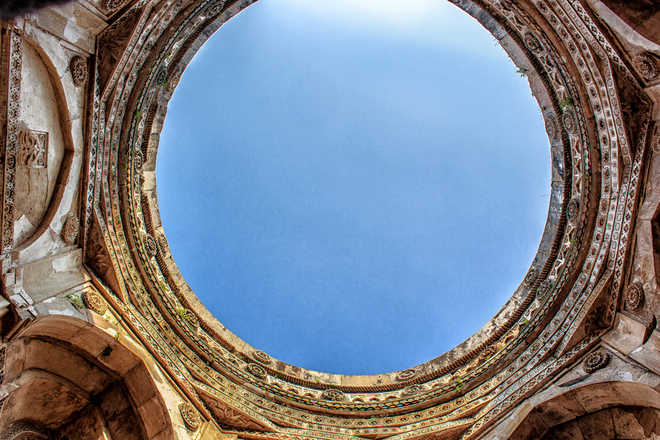
Art surrounds: Jami Masjid mesmerises with its Mughal architecture. Frescos in Persian and Hindu style are a treat to the eyes Photos by the writer
Aakash Mehrotra
There would be a few places in the architectural history of India that had gone from a place of moderate importance to become the capital of one of the most influential sultanate. Champaner was one such place. It flourished for decades, only to be attacked, ransacked and left deserted in just a span of a century. The rise and fall of its civilisation had been as volatile as a stock market.
A one hour journey from Vadodara brings you to this Unesco World Heritage site. Champaner was founded by the Rajput king Vanraj Chavda of the Chavda Kingdom in the 8th century. The neighbouring city of Pavagadh worked as a key strategic point on trade routes, emanating from Gujarat to the whole of India. Many Gujarat sultans attempted to capture Pavagadh. Mahmud Begda succeeded in doing so in 1484, after laying siege to the city for nearly two years. He renamed the city Mohammadabad and moved his capital from Ahmedabad to this city. In 1535, the city was captured by Mughal ruler Humayun, and since the Mughals had control over most areas, the city no longer enjoyed the status of a strategic trade point, and the capital was moved back to Ahmedabad. This marked the beginning of the decline of Champaner and rise of Ahmedabad.
Being the capital and a strategic centre, the city had huge fortifications, especially on the upper portions. Some mesmerising Mughal architecture can be still spotted. One such elegant structure is the Jami Masjid. With the dome at the entrance gate missing and intricate carvings on rusted iron pillars, the mosque seems wrapped in time. Frescos in Persian and Hindu style on the walls are a treat to the eyes. Close to it is Shehar ki Masjid, only meant for the royal family. Constructed on a raised plinth, the central arched entrance is well-supported by two minarets. The concept of raised plinth and architecture of minarets travelled far from here and became a part of many architectural designs later.
A long list of monuments waits for you on the Pavagarh trail. The first encounter on this trail is with the Pavagarh Fort. The wide fortification walls now stand in ruins. Inside these complexes, one can locate streets, civil baths, town patterns and even rows of shops, all having lived through the vagaries of time. The whole area is now an excavation site and government officials chance upon rare jewels every now and then.
As one moves uphill, following the path (pilgrim’s route) leading to the ropeway to the Kalikamata temple, one comes across many architectural structures that inspired many prototypes later. Inside the Pavagarh fort, are some old Hindu and Jain temples, standing as witness to the rich past of this place. Some monuments, which served as military bases and storage houses, are still intact.
One thing that makes Champaner stand out among other cities of its time is the adroit township, which one can still trace in the ruins. There were multiple stepwell and the vazu tanks in the mosques, which served dual purpose of water harvesting and religious ablutions. The big mosques like the Jami Masjid also had elaborate water-harvesting structures in their compounds.
Standing near the Bada Talao and Pavagarh hill forming the backdrop, as you gaze at the deserted streets, you can still imagine a kingdom, reduced from glory to dust, and forgotten for centuries. This has been the fate of several stranded monuments here — mosques lay abandoned, numerous water bodies reflect callousness of mankind, ramparts of the fort and structures waiting to be named.
Fast facts
- Champaner is around 50 Km from Vadodara, accessible by both bus and taxis.
- There are around 40 big and small monuments in Champaner and guide takes Rs 100 per monument. Despite being a world heritage site, there are no ASI licensed guides in Champaner. Trained locals double up as guides here. There are 11 monuments which have real importance and seeing them alone can take a full day.
- To stay: The resthouse of the Gujarat Tourism by the name Hotel Champaner is a decent option to stay. There are other small lodges in Pavagarh. For a luxury stay, one can opt for the Champaner Heritage Resorts.



























